Contents
- 1 What Is Internal Linking?
- 2 Why Internal Linking Matters for SEO
- 3 Key Benefits of Strategic Internal Linking
- 4 How to Create an Effective Internal Linking Strategy
- 5 Advanced Internal Linking Techniques
- 6 Common Internal Linking Mistakes to Avoid
- 7 Common Internal Linking Problems to Watch For
- 7.1 1. Links in Submission-Required Forms
- 7.2 2. Links Only Accessible Through Internal Search Boxes
- 7.3 3. Links in Un-Parseable JavaScript
- 7.4 4. Links in Flash, Java, or Other Plug-Ins
- 7.5 5. Links to Pages Blocked by the Meta Robots Tag or Robots.txt
- 7.6 6. Pages with Hundreds or Thousands of Links
- 7.7 7. Links in Frames or I-Frames
- 8 Tools for Analyzing and Improving Internal Links
- 9 Schema Markup for Enhanced Internal Linking
- 10 Internal Linking for Different Website Types
- 11 Case Studies: Internal Linking Success Stories
- 12 Frequently Asked Questions
- 12.1 1. How many internal links should a page have?
- 12.2 2. Does the location of internal links on a page matter?
- 12.3 3. Should I use exact-match keywords for all anchor text?
- 12.4 4. How can I find internal linking opportunities on my website?
- 12.5 5. When should I update my internal linking structure?
- 12.6 6. What is internal linking vs external linking?
- 12.7 7. Why are internal links important?
- 12.8 8. How many internal links are too many?
- 13 Conclusion: Building a Stronger Website Through Strategic Internal Linking
Imagine your website as a vibrant city. The pages are buildings, and the internal links? They’re the roads connecting everything together. Without these pathways, visitors would struggle to navigate between destinations, and similarly, search engines would have difficulty understanding your website’s structure and hierarchy.
Internal linking might not have the glamour of keyword research or the excitement of earning backlinks, but it’s often the unsung hero in successful SEO strategies. While many beginners focus solely on creating content and building external links, they miss this powerful opportunity hiding in plain sight – strategically connecting their own pages to boost their entire site’s visibility and authority.
In this comprehensive guide, we’ll uncover how proper internal linking can dramatically improve your site’s search performance, user experience, and conversion rates. Whether you’re just starting your SEO journey or looking to refine your strategy, mastering internal linking is a crucial skill that can give you a significant competitive edge.
What Is Internal Linking?
Definition and Basic Concepts
Internal linking is the practice of connecting one page on your website to another page on the same website. These links use the same domain in both the source and target URLs. This differs from external links, which connect to pages on different domains.
For example, when you link from your homepage to your “About Us” page or from one blog post to a related article, you’re creating internal links. A basic internal link appears in HTML as:
<a href="http://www.same-domain.com/page/" title="Keyword Text">Keyword Text</a>
These connections serve several important purposes:
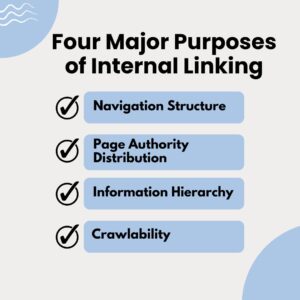
- Navigation Structure: They help visitors find their way around your website
- Page Authority Distribution: They pass authority (link equity) between pages
- Information Hierarchy: They establish relationships between content
- Crawlability: They create paths for search engines to discover and index your content
Types of Internal Links
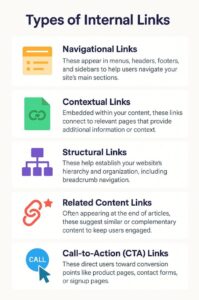
Not all internal links serve the same purpose. Understanding the different types can help you implement a more effective strategy:
- Navigational Links: These appear in menus, headers, footers, and sidebars to help users navigate your site’s main sections.
- Contextual Links: Embedded within your content, these links connect to relevant pages that provide additional information or context.
- Structural Links: These help establish your website’s hierarchy and organization, including breadcrumb navigation.
- Related Content Links: Often appearing at the end of articles, these suggest similar or complementary content to keep users engaged.
- Call-to-Action (CTA) Links: These direct users toward conversion points like product pages, contact forms, or signup pages.
Why Internal Linking Matters for SEO
Internal linking isn’t just about helping visitors navigate your site—it’s a powerful SEO technique that influences how search engines understand, crawl, and rank your content.
Search Engine Crawling and Indexing
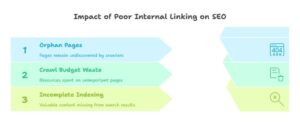
Search engines like Google use specialized software called “crawlers” or “spiders” to discover and analyze web pages. These crawlers follow links to move from one page to another. Without proper internal linking:
- Orphan Pages: Some content might remain undiscovered by search engines
- Crawl Budget Waste: Search engines might spend time on less important pages
- Incomplete Indexing: Your valuable content could be missing from search results
By implementing a strategic internal linking structure, you provide clear pathways for search engine crawlers to find, index, and understand all your important pages.
Authority Distribution Through Link Equity
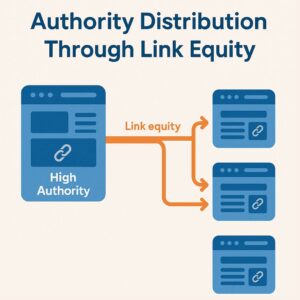
When a page receives external backlinks, it gains “authority” or “link equity” in the eyes of search engines. Internal links help distribute this authority throughout your website in a process sometimes called “link juice” flow.
Pages with high authority can pass some of that value to other pages they link to. This means your link-earning content can boost the ranking potential of your commercial or conversion-focused pages.
Establishing Content Relationships and Topic Clusters
Modern search engines use sophisticated algorithms to understand the relationships between concepts, topics, and entities. Internal linking helps establish these relationships on your website by creating topic clusters:
- Pillar Content: Comprehensive pages covering broad topics in depth
- Cluster Content: More specific pages that address individual aspects of the pillar topic
- Supporting Content: Related information that adds context and value
When you connect these content pieces through internal links, you signal to search engines that your website has comprehensive coverage and expertise in specific subject areas.
Key Benefits of Strategic Internal Linking
Implementing a thoughtful internal linking strategy offers numerous advantages beyond basic SEO:
Enhanced User Experience
Well-placed internal links can significantly improve how users interact with your site by:
- Reducing bounce rates by providing relevant next steps
- Increasing session duration and pages per visit
- Helping users discover useful related content
- Making important information more accessible
- Creating smoother conversion paths
Improved Content Discovery
Even your best content might go unnoticed if users can’t find it. Internal linking helps surface valuable but potentially overlooked content by:
- Revitalizing older articles through links from new content
- Highlighting cornerstone content that demonstrates your expertise
- Making specialized information more discoverable
- Creating multiple pathways to important resources
Better Keyword Targeting and Context

The text you use in your internal links (anchor text) provides additional context to both users and search engines about the linked page. This helps:
- Reinforce target keywords for specific pages
- Create semantic relationships between related topics
- Add context that helps search engines understand page content
- Improve accessibility for users with screen readers
How to Create an Effective Internal Linking Strategy
Now that we understand the importance of internal linking, let’s explore how to implement it effectively on your website.
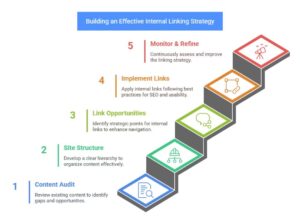
Step 1: Conduct a Content Audit
Before adding new internal links, you need to understand your existing content landscape:
- Create a Content Inventory: List all your website’s pages and categorize them by topic, funnel stage, and importance.
- Identify Top-Performing Pages: Find pages that already rank well or have significant external links.
- Discover Orphaned Content: Locate valuable pages with few or no internal links pointing to them.
- Map Content Relationships: Group related content into topic clusters to visualize potential connections.
Recommended Tool: Screaming Frog SEO Spider can help you crawl your website and identify pages with few internal links.
Step 2: Develop a Site Structure and Hierarchy
A logical website structure makes internal linking more intuitive and effective:
- Define Main Categories: Organize your content into clear, logical sections.
- Implement Proper URL Structure: Create URLs that reflect your site hierarchy (e.g., domain.com/category/subcategory/page-title).
- Create Siloed Content: Group related content together to build topical authority.
- Design Clear Navigation: Ensure your main menu showcases your most important categories.
Example Structure:
Homepage ├── Category A (Pillar Page) │ ├── Subcategory A1 │ │ ├── Content Page A1.1 │ │ ├── Content Page A1.2 │ ├── Subcategory A2 │ ├── Content Page A2.1 ├── Category B (Pillar Page) ├── Subcategory B1 ├── Content Page B1.1
The optimal structure resembles a pyramid, with your homepage at the top and progressively more specific content as you move down. This ensures the minimum number of links between your homepage and any given page, helping link equity flow efficiently throughout your site.
Step 3: Identify Link Opportunities
With your content mapped out, look for strategic linking opportunities:
- Related Content Links: Connect pages covering related subtopics or complementary information.
- Hierarchical Links: Link from specific topics up to broader category pages and vice versa.
- Chronological Links: Connect content that represents a sequence or progression.
- Conversion-Focused Links: Add links that guide users toward your business goals.
- Authority Distribution: Link from high-authority pages to important pages that need ranking boosts.
Step 4: Implement Internal Links with Best Practices
When adding internal links, follow these best practices for maximum impact:
- Use Descriptive Anchor Text: Make your link text informative and relevant to the destination page.
- Poor Example: “Click here” or “Read more”
- Good Example: “Learn about on-page SEO techniques” or “See our pricing options”
- Vary Your Anchor Text: Use a natural mix of exact-match keywords, partial-match phrases, and generic descriptions.
- Place Links Contextually: Add links within content where they make sense contextually, not just at the end or in sidebars.
- Prioritize User Experience: Only link when it provides genuine value to the reader; avoid excessive linking that distracts from the content.
- Consider Link Prominence: Links placed higher in the content often carry more weight with search engines.
- Use Follow/Nofollow Appropriately: Most internal links should be “follow” links, but consider “nofollow” for login pages, duplicate content, or policy pages.
Step 5: Monitor and Refine Your Strategy
Internal linking isn’t a “set and forget” tactic. Continuously improve your strategy by:
- Tracking Performance: Monitor how internal linking changes affect key metrics like rankings, organic traffic, and user behavior.
- Updating Outdated Links: Regularly check for and fix broken or outdated internal links.
- Adjusting Based on Data: Use analytics to identify which internal links drive engagement and which might need improvement.
- Expanding Link Networks: As you create new content, incorporate it into your existing internal linking structure.
Advanced Internal Linking Techniques
Once you’ve mastered the basics, consider these advanced approaches:
Topic Clusters and Pillar Pages
The topic cluster model organizes content around central “pillar” pages that comprehensively cover broad topics, with cluster content diving deeper into specific aspects:
- Create Comprehensive Pillar Content: Develop authoritative pages that broadly cover important topics for your industry.
- Build Supporting Cluster Content: Create more specialized content that links back to the relevant pillar page.
- Interlink Cluster Content: Connect related cluster pages to each other where contextually appropriate.
- Update Links Regularly: As you add new cluster content, update pillar pages to include links to it.
Example Topic Cluster for an SEO Agency:
- Pillar Page: “Complete Guide to Technical SEO”
- Cluster Content:
- “How to Create an XML Sitemap”
- “Mobile Optimization Best Practices”
- “Page Speed Optimization Techniques”
- “JavaScript SEO Fundamentals”
Hub Pages and Content Hubs
Hub pages are curated collections of links to related content, serving as navigational centers for specific topics:
- Identify Key Topics: Determine areas where you have substantial content coverage.
- Create Dedicated Hub Pages: Design pages that organize and introduce your content on specific topics.
- Add Contextual Information: Include brief descriptions of linked content to help users choose what to read next.
- Update Regularly: Add new content to hub pages as it’s published.
Example Hub Page Structure:
Ultimate Guide to Content Marketing ├── Introduction to the topic ├── Section: Content Strategy │ ├── Brief overview │ ├── Links to related articles with descriptions ├── Section: Content Creation │ ├── Brief overview │ ├── Links to related articles with descriptions
Strategic Anchor Text Optimization
The words you use in your links (anchor text) provide context about the linked page:
- Use Semantic Variations: Instead of repeatedly using the exact same keywords, include synonyms and related phrases.
- Include LSI Keywords: Incorporate Latent Semantic Indexing (LSI) keywords that relate to your main topics.
- Keep It Natural: Ensure anchor text reads naturally within the content, avoiding forced keyword insertion.
- Balance Keyword and Branded Anchors: Mix keyword-rich anchors with branded terms and generic phrases.
Examples of Varied Anchor Text:
- Target keyword: “SEO Tools”
- Anchor variations:
- “Popular SEO tools for beginners”
- “Software for search optimization”
- “Our favorite keyword research platforms”
- “These search visibility tools”
Internal Link Auditing and Maintenance
Regularly audit and maintain your internal linking structure:
- Identify and Fix Broken Links: Use tools like Screaming Frog or Google Search Console to find and fix broken internal links.
- Analyze Click Patterns: Review which internal links users actually click to understand what content connections resonate.
- Update Historical Content: Revisit older content to add links to newer related articles.
- Prune Unnecessary Links: Remove or replace links that point to irrelevant or low-value pages.
Common Internal Linking Mistakes to Avoid
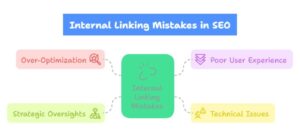
Even experienced SEO practitioners can make these common mistakes:
1. Over-Optimization
- Excessive Link Density: Placing too many links within a single piece of content
- Keyword Stuffing in Anchor Text: Repeatedly using the same keyword-rich anchor text
- Forced Contextual Links: Adding links that don’t naturally fit within the content
2. Poor User Experience
- Misleading Anchor Text: Using text that doesn’t accurately describe the destination page
- Opening Links in New Tabs Without Purpose: Disrupting user navigation unnecessarily
- Linking to Irrelevant Content: Creating connections that don’t provide value to users
3. Technical Issues
- Deep Linking Structures: Requiring too many clicks to reach important pages
- Inconsistent Navigation: Changing menu structures across different site sections
- Redirect Chains: Linking to URLs that redirect multiple times before reaching the final destination
4. Strategic Oversights
- Ignoring Mobile Experience: Not testing how internal links appear and function on mobile devices
- Neglecting Key Conversion Pages: Failing to direct link equity to important commercial pages
- Siloing Content Too Strictly: Creating isolated sections with few connections to other site areas
Common Internal Linking Problems to Watch For
Avoid these potential issues that can undermine your internal linking strategy:
1. Links in Submission-Required Forms
Forms can include elements as basic as a drop-down menu or as complex as a full-blown survey. Search spiders will not attempt to “submit” forms, and thus, any content or links accessible only via forms are invisible to search engines.
2. Links Only Accessible Through Internal Search Boxes
Spiders will not perform searches to find content, making pages accessible only through search boxes effectively invisible to search engines.
3. Links in Un-Parseable JavaScript
Links built using JavaScript may be uncrawlable or devalued depending on their implementation. For better SEO, use standard HTML links rather than JavaScript-based links.
4. Links in Flash, Java, or Other Plug-Ins
Links embedded inside Flash, Java applets, and other plug-ins are usually inaccessible to search engines.
5. Links to Pages Blocked by the Meta Robots Tag or Robots.txt
The Meta Robots tag and robots.txt file allow site owners to restrict spider access to pages, but this can disrupt your internal linking structure.
6. Pages with Hundreds or Thousands of Links
Search engines typically have a crawl limit of approximately 150 links per page. Exceeding this may result in some links not being followed, so limit links to around 150 per page when possible.
7. Links in Frames or I-Frames
While technically crawlable, frames and I-frames present structural issues for search engines in terms of organization and following, and should be used cautiously.
Tools for Analyzing and Improving Internal Links
Several tools can help you analyze and optimize your internal linking strategy:
Free Tools
- Google Search Console: Identifies crawl errors and provides internal links reports
- Screaming Frog SEO Spider (Free Version): Crawls up to 500 URLs and provides internal link data
- Sitebulb Lite: Offers limited free crawling and basic internal link analysis
Paid Tools
- Semrush: Provides site audit features with internal linking suggestions
- Ahrefs: Offers detailed site structure visualization and internal link reports
- Sitebulb: Delivers comprehensive internal link analysis and visualization
- Netpeak Spider: Specializes in identifying internal linking issues and opportunities
- Moz Pro: Helps identify crawl depth for pages on your site
Schema Markup for Enhanced Internal Linking
Schema markup can complement your internal linking strategy by providing additional context to search engines:
- BreadcrumbList Schema: Enhances breadcrumb navigation display in search results
- SiteNavigationElement Schema: Clarifies your main navigation structure
- Article Schema with hasPart/isPartOf: Establishes relationships between content pieces
- ItemList Schema: Organizes sequences of related content items
Example BreadcrumbList Schema:
{ "@context": "https://schema.org", "@type": "BreadcrumbList", "itemListElement": [ { "@type": "ListItem", "position": 1, "name": "SEO Guide", "item": "https://example.com/seo-guide/" }, { "@type": "ListItem", "position": 2, "name": "Internal Linking", "item": "https://example.com/seo-guide/internal-linking/" } ] }
Internal Linking for Different Website Types
Different types of websites require tailored internal linking approaches:
E-commerce Websites
Priority Links:
- Category to subcategory connections
- Product to related product links
- Informational content to product pages
- Buyer’s guides to product categories
Best Practices:
- Use breadcrumb navigation
- Implement related/complementary product sections
- Create category hub pages with featured products
- Link from product descriptions to helpful resources
Blog and Publication Sites
Priority Links:
- Topic cluster connections
- Chronological series links
- Related article suggestions
- Resource library connections
Best Practices:
- Create topic index pages
- Implement “recently published” and “popular posts” sections
- Use inline contextual links within content
- Add “further reading” sections at article conclusions
Service-Based Business Sites
Priority Links:
- Service to subservice connections
- Case study to service links
- Blog content to relevant service pages
- FAQ to service page connections
Best Practices:
- Link from problem descriptions to solution pages
- Create service comparison content with appropriate links
- Use testimonials with links to relevant service descriptions
- Implement a resources section with links to service details
Case Studies: Internal Linking Success Stories
Case Study 1: E-commerce Category Optimization
A mid-sized online retailer implemented a strategic internal linking plan for their product categories:
Challenge: Product categories had poor visibility in search despite having quality content.
Solution:
- Created hub pages for each main category
- Implemented a related products section with descriptive anchor text
- Added contextual links from blog content to relevant category pages
Results:
- 43% increase in organic traffic to category pages
- 27% reduction in bounce rate
- 18% improvement in average session duration
Case Study 2: Blog Content Revitalization
A B2B software company revamped their blog’s internal linking structure:
Challenge: Valuable older content was getting buried and receiving minimal traffic.
Solution:
- Conducted a content audit to identify high-value but underperforming articles
- Created topic clusters around key service areas
- Updated newer posts with links to relevant older content
- Implemented a “related reading” section at the end of each article
Results:
- 67% increase in traffic to previously underperforming content
- 52% improvement in pages per session
- 38% increase in organic keywords ranked in top 10 positions
Frequently Asked Questions
1. How many internal links should a page have?
There’s no universal “perfect” number of internal links per page. Rather than focusing on quantity, prioritize quality and relevance. Most SEO experts recommend having at least 3-5 internal links per page for basic connectivity, but longer content may naturally include more. The key is ensuring each link adds value for both users and search engines.
2. Does the location of internal links on a page matter?
Yes, link placement can impact both SEO value and user engagement. Links placed within the main content area typically carry more weight than those in headers, footers, or sidebars. Additionally, links appearing higher in the content often receive more SEO value and user clicks than those placed toward the bottom of a page.
3. Should I use exact-match keywords for all anchor text?
No, using exact-match keywords for all anchor text can appear manipulative to search engines and potentially trigger over-optimization penalties. Instead, use a natural mix of:
- Exact-match keywords (carefully and sparingly)
- Partial-match keywords and phrases
- Branded terms
- Generic terms (when appropriate)
- Descriptive phrases that explain what users will find
4. How can I find internal linking opportunities on my website?
To identify internal linking opportunities:
- Use site search (site:yourdomain.com keyword) to find relevant content
- Create a content inventory organized by topic
- Use tools like Screaming Frog to identify pages with few internal links
- Review your most popular content for opportunities to link to underperforming pages
- Analyze competitor sites for content relationship ideas
5. When should I update my internal linking structure?
Your internal linking structure should be reviewed and updated:
- When publishing new content
- After conducting a content audit (recommended quarterly)
- When you notice significant changes in organic traffic or rankings
- After redesigning or restructuring your website
- When implementing new SEO strategies
6. What is internal linking vs external linking?
Internal linking occurs when a site links to other URLs on the same site, whereas external linking occurs when a site links to URLs on a different domain. Put another way, internal links are when you link to your own pages, while external links point to pages on other domains. External links pointing to a page can significantly enhance its authority, making them an important aspect of SEO.
7. Why are internal links important?
Internal links are important because they can help Google understand and rank your website better. By giving Google links to follow along with descriptive anchor text, you can indicate which pages of your site are important, as well as what they are about. Internal links are also good for user experience and may improve engagement.
8. How many internal links are too many?
While there is no definite answer as to how many internal links on a page are too many, Google has indicated they can crawl hundreds of links per page. Practically speaking, lots of links isn’t always good for user experience, and limiting the number of links per page to a reasonable number (typically around 100-150 or less) can provide additional SEO benefits.
Conclusion: Building a Stronger Website Through Strategic Internal Linking
Internal linking might not be the most glamorous aspect of SEO, but it’s undoubtedly one of the most powerful tools at your disposal. By thoughtfully connecting your content, you create a more navigable website for users, a more crawlable structure for search engines, and a more authoritative presence in your industry.
Remember that effective internal linking isn’t about following rigid formulas or achieving specific link quantities. Instead, focus on creating meaningful connections that enhance user experience and communicate the relationships between your content to search engines.
As search algorithms continue to evolve toward understanding topics, entities, and user intent, a well-structured website with logical internal linking will increasingly become a competitive advantage. By implementing the strategies outlined in this guide, you’re not just optimizing for today’s SEO best practices—you’re building a content ecosystem that will continue delivering value well into the future.
Start small by auditing your existing structure, identifying key opportunities, and gradually implementing improvements. Monitor the results, refine your approach based on data, and continue building those valuable pathways through your digital property.
Have you implemented any of these internal linking strategies on your website? What results have you seen? Share your experiences in the comments below!
Hi, I’m Mitu Chowdhary — an SEO enthusiast turned expert who genuinely enjoys helping people understand how search engines work. With this Blog, I focus on making SEO feel less overwhelming and more approachable for anyone who wants to learn — whether you’re just getting started or running a business and trying to grow online.
I write for beginners, small business owners, service providers — anyone curious about how to get found on Google and build a real online presence. My goal is to break down SEO into simple, practical steps that you can actually use, without the confusing technical jargon.
Every post I share comes from a place of wanting to help — not just to explain what SEO is, but to show you how to make it work for you. If something doesn’t make sense, I want this blog to be the place where it finally clicks.
I believe good SEO is about clarity, consistency, and a bit of creativity — and that’s exactly what I try to bring to every article here.
Thanks for stopping by. I hope you find something helpful here!

